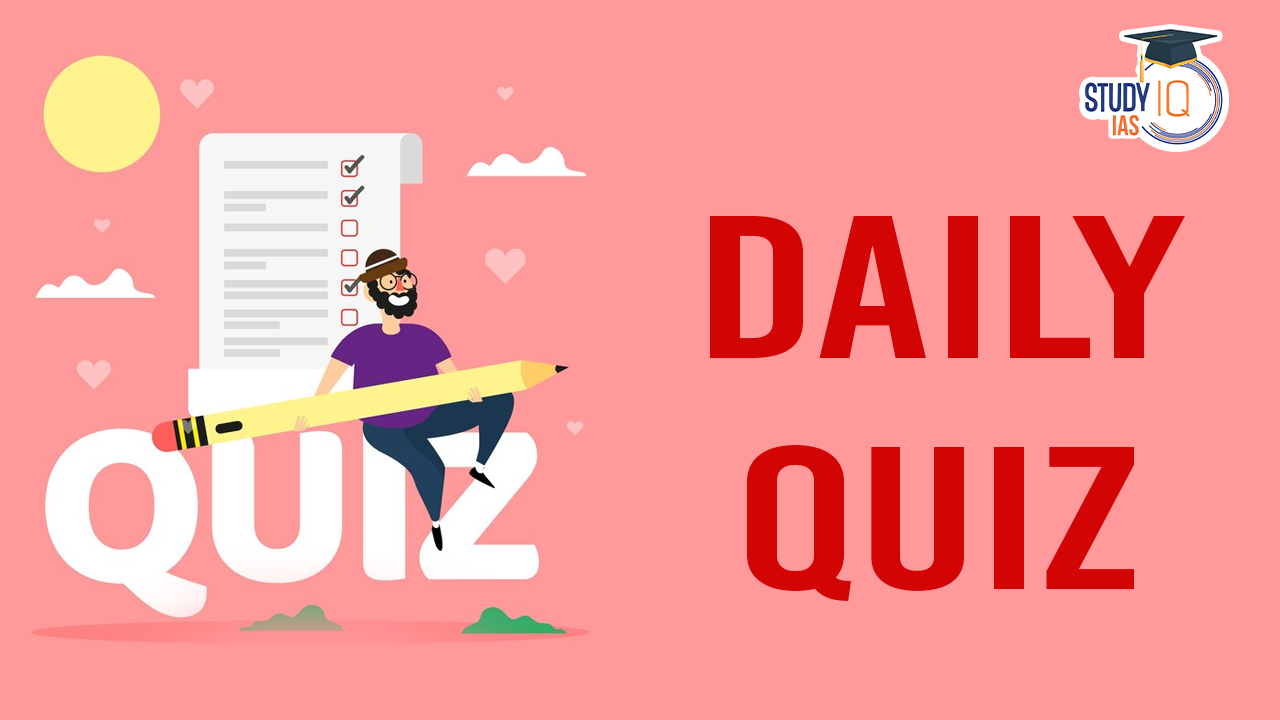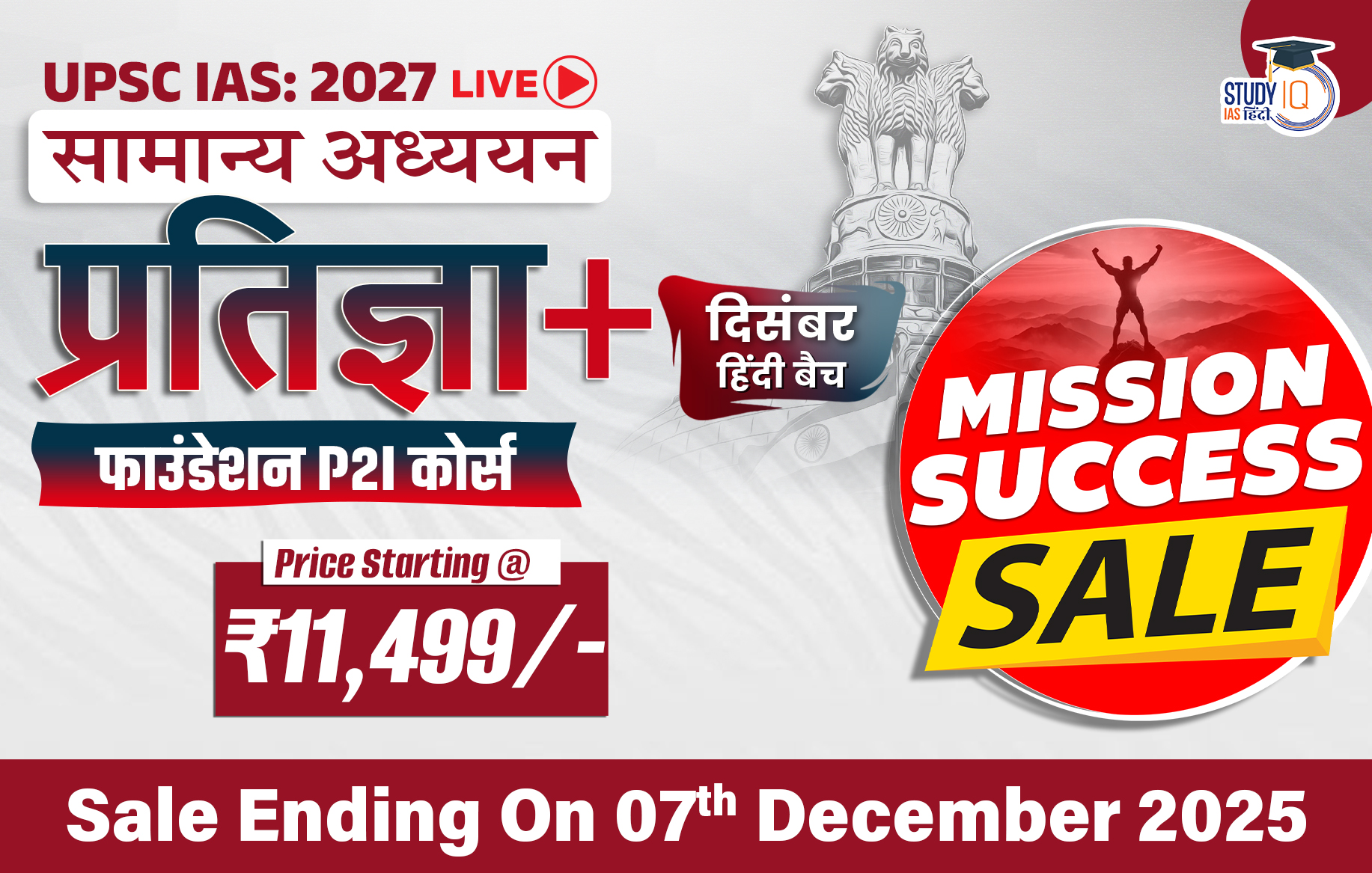Daily Quiz 02 July 2025
Quiz-summary
0 of 5 questions completed
Questions:
- 1
- 2
- 3
- 4
- 5
Information
- Click on – ‘Start Quiz’ button
- Solve Questions
- Click on ‘Next’ button
- Click on ‘Finish Quiz’ button
- Now click on ‘View Questions’ button – here you will see solutions and links.
- The test contains a total of 5 questions.
- Click on the most appropriate option to mark it as your answer.
- You will be awarded Two marks for each correct answer.
- You can change your answer by clicking on some other option.
- A Number list of all questions appears at the top side of the screen.
- You can access the questions in any order by clicking on the question number given on the number list.
- You can use rough sheets while taking the test.
- Do not use calculators, log tables, dictionaries, or any other printed/online reference material during the test.
- Do not click the button “Finish Quiz” before completing the test. A test once submitted cannot be resumed.
You have already completed the quiz before. Hence you can not start it again.
Quiz is loading...
You must sign in or sign up to start the quiz.
You have to finish following quiz, to start this quiz:
- 1
- 2
- 3
- 4
- 5
- Answered
- Review
-
Question 1 of 5
1. Question
1 pointsConsider the following statements regarding the Cash Plus Model in Rajasthan:
Statement I: The Cash Plus Model augments PMMVY by combining DBT with nutrition counselling for pregnant and lactating women.
Statement II: The model excludes second-time mothers from its benefits to prioritize first pregnancies.
Statement III: It has demonstrated significant improvement in early breastfeeding rates and dietary diversity.
Which one of the following is correct in respect of the above statements?Correct
Answer: (b)
Explanation:
• Statement I is correct:
The model enhances PMMVY (which offers DBT to pregnant women) by adding behavioural change communication — such as counselling, home visits, group sessions.
• Statement II is incorrect:
Unlike PMMVY (which targets first-time mothers), Cash Plus includes second-time mothers, recognizing that maternal health support is needed beyond the first child.
• Statement III is correct:
Data from the pilot in Rajasthan shows 49% increase in early breastfeeding, 54% more women using funds for nutrition, and improved dietary diversity.
Correct answer: (b)Incorrect
Answer: (b)
Explanation:
• Statement I is correct:
The model enhances PMMVY (which offers DBT to pregnant women) by adding behavioural change communication — such as counselling, home visits, group sessions.
• Statement II is incorrect:
Unlike PMMVY (which targets first-time mothers), Cash Plus includes second-time mothers, recognizing that maternal health support is needed beyond the first child.
• Statement III is correct:
Data from the pilot in Rajasthan shows 49% increase in early breastfeeding, 54% more women using funds for nutrition, and improved dietary diversity.
Correct answer: (b) -
Question 2 of 5
2. Question
1 pointsMatch List-I with List-II and select the correct code:
List-I (Government Policy/Programme) List-II (Implementing Ministry/Body) A. DigiYatra 1. Ministry of Civil Aviation (MoCA) B. GAGAN 2. Indian Space Research Organisation (ISRO) and Airport Authority of India C. Aircraft Leasing at GIFT City 3. International Financial Services Centres Authority (IFSCA) D. Make in India – Aviation 4. Department for Promotion of Industry and Internal Trade (DPIIT) How many of the pairs given above are correctly matched?
Correct
Answer: D
Explanation:
1: DigiYatra → Ministry of Civil Aviation (MoCA)
- DigiYatra is a flagship digital initiative by the Ministry of Civil Aviation to ensure a seamless and contactless air travel experience for passengers.
- It uses facial recognition technology (FRT) to enable biometric-based digital processing at various checkpoints like check-in, security, and boarding.
- It aims to reduce waiting time, increase throughput, and improve overall efficiency at airports.
- The initiative supports the government’s vision of paperless and tech-driven air travel under the broader Digital India
2: GAGAN → ISRO and Airport Authority of India (AAI)
- GAGAN (GPS-Aided GEO Augmented Navigation) is a satellite-based augmentation system (SBAS) developed jointly by ISRO and AAI.
- It improves the accuracy and integrity of GPS signals for civil aviation applications, especially for en-route and terminal navigation.
- It ensures precision approach and landing capabilities at airports lacking ground-based navigation aids, especially in hilly and remote regions.
- GAGAN is also used in disaster management, railways, and surveying beyond aviation.
3: Aircraft Leasing at GIFT City → IFSCA
- Aircraft leasing and financing operations at GIFT City (Gujarat International Finance Tec-City) are regulated by the International Financial Services Centres Authority (IFSCA).
- The aim is to reduce India’s dependence on foreign aircraft leasing hubs (like Ireland) and retain leasing revenue domestically.
- India’s airlines lease over 80% of their aircraft; this initiative promotes Make in India Financing, legal ease, and financial sector development.
- It also aims to position India as a global hub for aircraft leasing, aligning with Atmanirbhar Bharat.
4: Make in India – Aviation → DPIIT
- The Make in India (Aviation) initiative is overseen by the Department for Promotion of Industry and Internal Trade (DPIIT).
- It encourages domestic manufacturing of aircraft components, engines, avionics, and other aerospace products.
- The program incentivizes companies like TATA-Airbus (C-295 aircraft plant in Gujarat) and HAL–Safran partnerships.
It helps in building indigenous capabilities, reducing import dependency, and creating skilled jobs in the aviation manufacturing ecosystem.
Incorrect
Answer: D
Explanation:
1: DigiYatra → Ministry of Civil Aviation (MoCA)
- DigiYatra is a flagship digital initiative by the Ministry of Civil Aviation to ensure a seamless and contactless air travel experience for passengers.
- It uses facial recognition technology (FRT) to enable biometric-based digital processing at various checkpoints like check-in, security, and boarding.
- It aims to reduce waiting time, increase throughput, and improve overall efficiency at airports.
- The initiative supports the government’s vision of paperless and tech-driven air travel under the broader Digital India
2: GAGAN → ISRO and Airport Authority of India (AAI)
- GAGAN (GPS-Aided GEO Augmented Navigation) is a satellite-based augmentation system (SBAS) developed jointly by ISRO and AAI.
- It improves the accuracy and integrity of GPS signals for civil aviation applications, especially for en-route and terminal navigation.
- It ensures precision approach and landing capabilities at airports lacking ground-based navigation aids, especially in hilly and remote regions.
- GAGAN is also used in disaster management, railways, and surveying beyond aviation.
3: Aircraft Leasing at GIFT City → IFSCA
- Aircraft leasing and financing operations at GIFT City (Gujarat International Finance Tec-City) are regulated by the International Financial Services Centres Authority (IFSCA).
- The aim is to reduce India’s dependence on foreign aircraft leasing hubs (like Ireland) and retain leasing revenue domestically.
- India’s airlines lease over 80% of their aircraft; this initiative promotes Make in India Financing, legal ease, and financial sector development.
- It also aims to position India as a global hub for aircraft leasing, aligning with Atmanirbhar Bharat.
4: Make in India – Aviation → DPIIT
- The Make in India (Aviation) initiative is overseen by the Department for Promotion of Industry and Internal Trade (DPIIT).
- It encourages domestic manufacturing of aircraft components, engines, avionics, and other aerospace products.
- The program incentivizes companies like TATA-Airbus (C-295 aircraft plant in Gujarat) and HAL–Safran partnerships.
It helps in building indigenous capabilities, reducing import dependency, and creating skilled jobs in the aviation manufacturing ecosystem.
-
Question 3 of 5
3. Question
1 pointsConsider the following statements regarding India’s pension system:
- Fragmentation of pension schemes under different agencies has led to inefficiencies and reduced coverage.
II. Atal Pension Yojana is a mandatory pension scheme for all informal sector workers in India.
Which of the statements given above is/are correct?
Correct
Answer: (a)
Explanation:
- Statement I is correct.
India’s pension ecosystem includes multiple schemes run by different bodies—EPFO (Employees’ Provident Fund Organisation), PFRDA (Pension Fund Regulatory and Development Authority), Atal Pension Yojana (APY), National Pension System (NPS), and various state-level pension programs. This fragmentation results in:- Duplication of efforts, lack of portability of pension accounts.
- Confusion for workers, especially gig workers, who are unclear about eligibility and contributions.
- Administrative inefficiencies that hinder effective outreach and uniform coverage.
- Statement II is incorrect.
The Atal Pension Yojana (APY) is a voluntary pension scheme launched in 2015, primarily targeted at informal sector workers. It provides a guaranteed monthly pension (₹1,000 to ₹5,000) after the age of 60. However:- Workers must opt-in voluntarily; it is not mandatory.
- Enrolment remains low due to lack of awareness, low trust in government schemes, and irregular income patterns of informal workers.
Hence, only Statement I is correct.
Incorrect
Answer: (a)
Explanation:
- Statement I is correct.
India’s pension ecosystem includes multiple schemes run by different bodies—EPFO (Employees’ Provident Fund Organisation), PFRDA (Pension Fund Regulatory and Development Authority), Atal Pension Yojana (APY), National Pension System (NPS), and various state-level pension programs. This fragmentation results in:- Duplication of efforts, lack of portability of pension accounts.
- Confusion for workers, especially gig workers, who are unclear about eligibility and contributions.
- Administrative inefficiencies that hinder effective outreach and uniform coverage.
- Statement II is incorrect.
The Atal Pension Yojana (APY) is a voluntary pension scheme launched in 2015, primarily targeted at informal sector workers. It provides a guaranteed monthly pension (₹1,000 to ₹5,000) after the age of 60. However:- Workers must opt-in voluntarily; it is not mandatory.
- Enrolment remains low due to lack of awareness, low trust in government schemes, and irregular income patterns of informal workers.
Hence, only Statement I is correct.
- Fragmentation of pension schemes under different agencies has led to inefficiencies and reduced coverage.
-
Question 4 of 5
4. Question
1 pointsConsider the following statements regarding delays in India’s district courts:
- The “unit-based” performance evaluation system equally rewards judges for disposing of simple and complex cases.
II. Most under-trial prisoners in Indian jails have already been convicted but are awaiting sentencing.
Which of the statements given above is/are correct?
Correct
Answer: (a)
Explanation:
- Statement I is correct.
District judges in India are often evaluated using a “unit system” where each judicial action—whether a simple bail order or a complex cross-examination—is awarded the same unit. This system:- Incentivizes judges to prioritize quick disposals of simpler cases to meet targets.
- Neglects complex and long-pending trials, leading to delays in justice.
- Discourages qualitative judgment and contributes to mechanical disposals, especially in high-stakes civil or criminal matters.
- Statement II is incorrect.
Under-trial prisoners are individuals who are awaiting trial or judgment—they have not yet been convicted.- Over 70% of India’s prison population consists of under-trials (as per NCRB).
- This indicates significant judicial delays, resulting in prolonged detention without guilt being legally established.
- The statement confuses under-trials with convicts, which is factually inaccurate.
Hence, only Statement I is correct.
Incorrect
Answer: (a)
Explanation:
- Statement I is correct.
District judges in India are often evaluated using a “unit system” where each judicial action—whether a simple bail order or a complex cross-examination—is awarded the same unit. This system:- Incentivizes judges to prioritize quick disposals of simpler cases to meet targets.
- Neglects complex and long-pending trials, leading to delays in justice.
- Discourages qualitative judgment and contributes to mechanical disposals, especially in high-stakes civil or criminal matters.
- Statement II is incorrect.
Under-trial prisoners are individuals who are awaiting trial or judgment—they have not yet been convicted.- Over 70% of India’s prison population consists of under-trials (as per NCRB).
- This indicates significant judicial delays, resulting in prolonged detention without guilt being legally established.
- The statement confuses under-trials with convicts, which is factually inaccurate.
Hence, only Statement I is correct.
- The “unit-based” performance evaluation system equally rewards judges for disposing of simple and complex cases.
-
Question 5 of 5
5. Question
1 pointsConsider the following statements regarding the Global Gender Gap Report 2025 and India’s performance:
- India has achieved full gender parity in educational attainment according to the 2025 report.
- India’s ranking in political empowerment has improved from the previous year due to increased female ministerial participation.
- India’s overall gender gap parity score remains below the global average as well as below most South Asian neighbours.
- The World Economic Forum, which publishes this report, also publishes the Global Innovation Index and Global Hunger Index.
How many of the statements given above are correct?
Correct
Answer: A
Explanation:
- Statement 1: Incorrect.India has not achieved full gender parity in educational attainment.
Its score stands at 97.1%, which is near parity but not full parity (100%).
Also, this progress is driven mainly by improved literacy and tertiary enrollment, but gaps remain in quality, regional disparities, and dropout rates. - Statement 2: Incorrect.Contrary to the claim, India’s performance in political empowerment has declined, not improved.
- Women’s representation in Parliament fell to 13.8% (from 14.7%).
- Share of women in ministerial positions also declined to 5.6% (from 6.5%).
Hence, India’s ranking fell further in this dimension.
- Statement 3: Correct.India’s overall gender parity score is 64.1%, which is:
- Lower than the global average of 68.8%
- Lower than most South Asian countries such as Bangladesh (24th), Nepal (125), Bhutan (119), and Sri Lanka (130)
Only Pakistan (148) and Maldives (138) perform worse than India in the region.
- Lower than most South Asian countries such as Bangladesh (24th), Nepal (125), Bhutan (119), and Sri Lanka (130)
- Statement 4: Incorrect: While the World Economic Forum (WEF) publishes several global reports like:
- Global Gender Gap Report
- Global Competitiveness Report
- Global Risks Report
- Global Travel and Tourism Report
It does not publish the Global Innovation Index (published by WIPO, INSEAD & Cornell University), nor the Global Hunger Index (published by Concern Worldwide &Welthungerhilfe).
Incorrect
Answer: A
Explanation:
- Statement 1: Incorrect.India has not achieved full gender parity in educational attainment.
Its score stands at 97.1%, which is near parity but not full parity (100%).
Also, this progress is driven mainly by improved literacy and tertiary enrollment, but gaps remain in quality, regional disparities, and dropout rates. - Statement 2: Incorrect.Contrary to the claim, India’s performance in political empowerment has declined, not improved.
- Women’s representation in Parliament fell to 13.8% (from 14.7%).
- Share of women in ministerial positions also declined to 5.6% (from 6.5%).
Hence, India’s ranking fell further in this dimension.
- Statement 3: Correct.India’s overall gender parity score is 64.1%, which is:
- Lower than the global average of 68.8%
- Lower than most South Asian countries such as Bangladesh (24th), Nepal (125), Bhutan (119), and Sri Lanka (130)
Only Pakistan (148) and Maldives (138) perform worse than India in the region.
- Lower than most South Asian countries such as Bangladesh (24th), Nepal (125), Bhutan (119), and Sri Lanka (130)
- Statement 4: Incorrect: While the World Economic Forum (WEF) publishes several global reports like:
- Global Gender Gap Report
- Global Competitiveness Report
- Global Risks Report
- Global Travel and Tourism Report
It does not publish the Global Innovation Index (published by WIPO, INSEAD & Cornell University), nor the Global Hunger Index (published by Concern Worldwide &Welthungerhilfe).
Results
0 of 5 questions answered correctly
Your time:
Time has elapsed
You have reached 0 of 0 points, (0)
| Average score |
|
| Your score |
|
Categories
- Not categorized 0%
| Pos. | Name | Entered on | Points | Result |
|---|---|---|---|---|
| Table is loading | ||||
| No data available | ||||
Sharing is caring!


 Daily Quiz 18 September 2025
Daily Quiz 18 September 2025

























